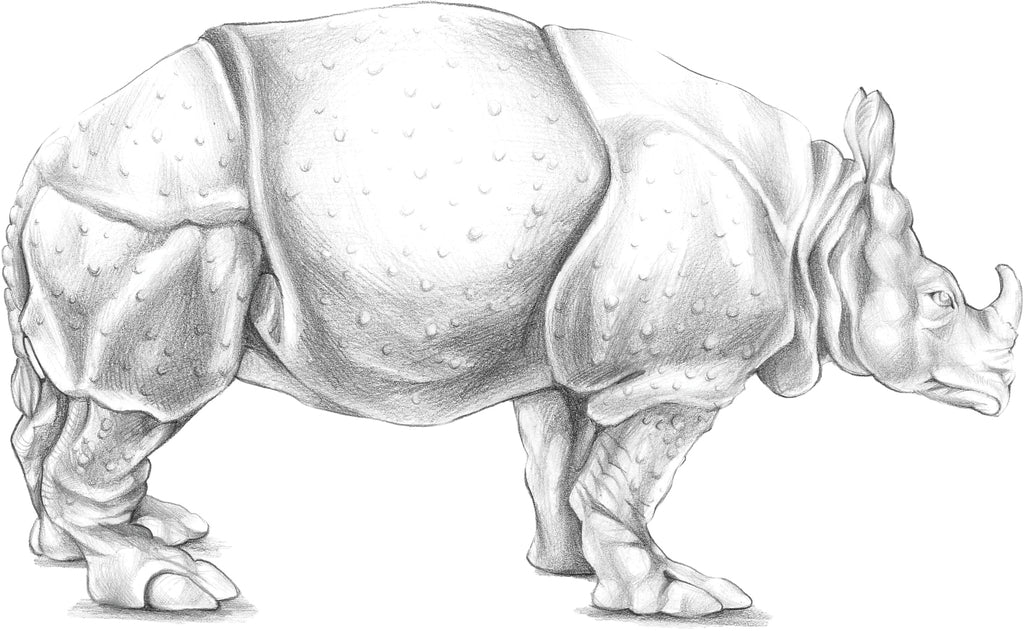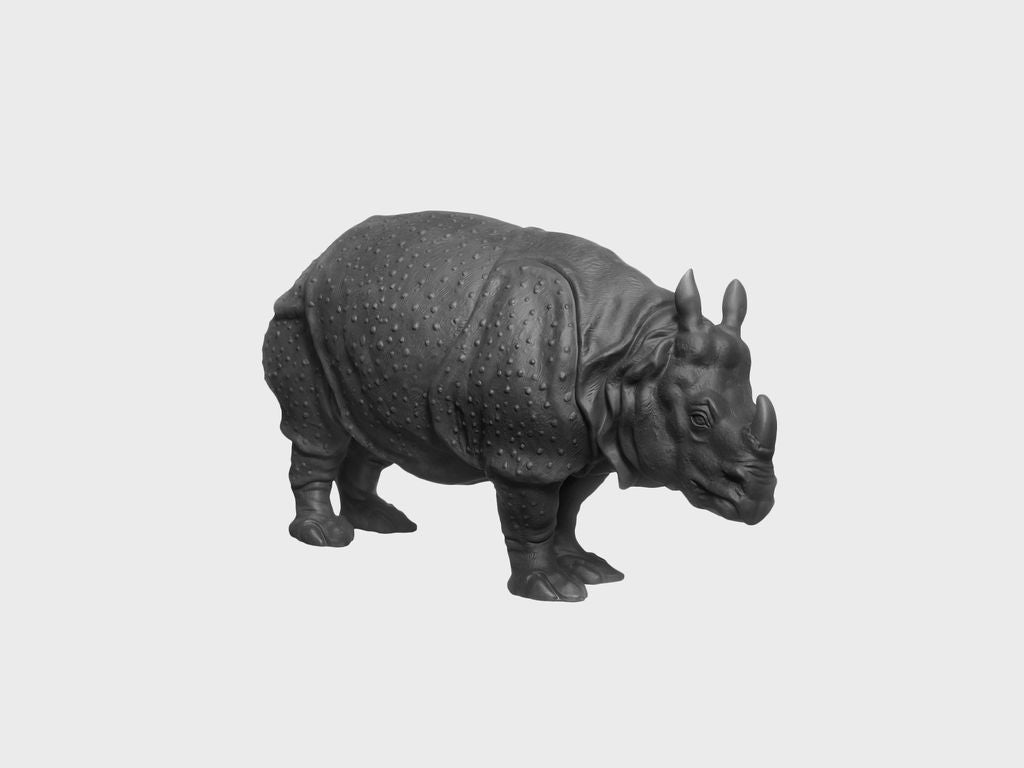
CLARA
Clara, meticulously modelled with great attention to detail and craftsmanship, gazes across tables and dining settings with an expression both proudly unwavering and slightly mischievous. This makes the rhinoceros lady an ideal conversational piece. In the early 19th century, such objects were designed to spark conversation and create connections among guests. Clara has had countless admirers worldwide for centuries – her story is as unique as the process of her creation in the manufactory.
-
CLARA´S JOURNEY FROM INDIA TO EUROPE
No figure offers more material for conversation than Clara. The story of the real-life original’s adventurous life could fill an entire evening. Clara was a superstar of the 18th century, a Grande Dame in every sense of the word. Yet her life began dramatically. Hunters shot the mother of the one-month-old baby rhinoceros, and in the wild, it stood no chance of survival. Thus, a search began for a new family. The Director of the East India Company in Bengal took in the orphan and kept her as a pet and playmate for his children at his estate near Calcutta. However, the rhinoceros soon became too large, and a new plan was needed. Dutch captain Douwe Mout purchased her from the family, took her aboard his ship to Europe, and had grand plans for little Clara.
-

-

-
CLARA MANIA: A CONTINENT IN AWE
The armour-plated rhinoceros survived the journey better than many human passengers: Clara was fed straw, bread, and fresh oranges by the crew, and her skin was regularly massaged with fish oil. When Rotterdam harbour was finally reached after several weeks in 1741, the sailor found success as a showman, making his exotic cargo a sensation. In the Age of Enlightenment, curiosity about exotic creatures was immense, and few had ever seen such an imposing animal in the flesh. Clara travelled in grand style on a wagon drawn by eight horses, from Hamburg to Basel, London and Vienna to Paris, through Denmark and to Venice for Carnival. Wherever the gentle rhinoceros lady appeared, she attracted crowds and caused a sensation – fashionable ladies wore wigs 'à la rhinocéros', while gentlemen customised their carriages with armour-like decorations.
-
GUEST OF THE POWERFUL AND MONARCHS
Behind this tour, which was to last 17 years, lay logistical mastery and shrewd marketing strategy. Everyone wanted to see the animal: common citizens, scientists, and especially the powerful. In Berlin, Frederick the Great paid twelve gold ducats for the performance. In Vienna, Empress Maria Theresa paid her respects to the rhinoceros and granted Douwe permission to move freely within the Holy Roman Empire. Emperor Francis I ennobled Clara’s owner, who was thereafter known as Douwe van der Meer. At the court of Versailles, the excitement reached its zenith when King Louis XV requested an audience in 1748. The French monarch was so taken with Clara that he wanted to acquire her for his private zoo – but van der Meer demanded a price too high even for the great-grandson of the Sun King.
-

-

-
MUSE FOR POETS, THINKERS, AND LADIES
But it was not only the nobility who were fascinated; the fine arts also admiringly turned their attention to the thick-skinned lady. voltaire, madame pompadour, diderot, jean-baptiste oudry, and giacomo casanova – clara was immortalised in numerous paintings, stories, and letters. even peter anton van verschaffelt, the sculptor and architect from ghent who was in high demand throughout europe, was deeply impressed by clara. twelve years after her death – she passed away in 1758 in london at the age of 20 – van verschaffelt created a sculpture of the famous rhinoceros on commission from a prince, faithfully crafting the details of the armour and gentle eyes.
-
THE STAR OF NYMPHENBURG
Based on Van Verschaffelt’s designs, Clara is still produced today in the master workshops of the Nymphenburg Porcelain Manufactory. Each figure involves eight different casting moulds and xxxx hours of work. 'Clara brings a smile to the face of every viewer, both then and now. She often accompanies me to events and is much more than mere decoration; she opens hearts,' says Anders Thomas, Managing Director of the Porcelain Manufactory. Whether in biscuit porcelain or glazed, in white or black, Clara still does today what distinguished her over 260 years ago: the rhinoceros inspires awe, sparks conversations, and brings a touch of magic wherever she appears.
-

"A rhinoceros on the table? Lady Clara the rhinoceros has been making a remarkable impression as a conversation starter and centerpiece since the 18th century. The porcelain sculpture was inspired by a genuine superstar of her time."
ANDERS THOMAS (CEO)
Our Clara

Delicate and subtle. Pure white and gentle. An icebreaker, without actually breaking any ice. Clara is the icon of the Nymphenburg Manufactory. The rhinoceros, modelled in 1770 by Peter Anton van Verschaffelt after the first specimen of a Bengal rhinoceros in Europe, appears to us today as almost more modern than it did back then. Clara is a classic conversational piece. She provides conversation wherever she appears; she inspires, captivates, and decorates with fascinating beauty. The biscuit porcelain version particularly highlights the tactile nuances of the armoured behemoth’s surface texture. Clara is beautifully touchable and unique!

RHINOZEROS CLARA, weiß, glasiert

RHINOZEROS CLARA, schwarz, biskuit

RHINOZEROS CLARA, weiß, biskuit
CLARA, A DELICATE ICON FOR ETERNITY
Before a porcelain Clara embarks on her journey around the world, to attend gatherings, break the ice at dinner conversations, or mischievously peek out from the shelf, she has already travelled a long path through the Nymphenburg Porcelain Manufactory.
First, the plaster moulds for the rhinoceros figure are retrieved from the archive, where they are stored along with 30,000 other models. Eight different moulds are used for a rhinoceros: four for the legs, two for the ears, one for the horn, and one for the body. These are individually filled with slip in the manufactory’s moulding department. The mixture sets for half an hour to achieve the correct thickness – or rather, thinness. While the skin of real rhinoceroses is four centimetres thick, the porcelain must be just four millimetres thin. The individual parts are then hand-engraved, with each craftsman using their own specially made tools. The pieces are then freed from the seams and assembled in the modelling room, where the complete figure can be admired for the first time. The rhinoceros is then finally retouched and left to dry for several days. After this, the still grey Clara is carefully moved to the kiln. A first so-called bisque firing hardens the porcelain blank at exactly 925 degrees Celsius. From this point, the processes diverge: the glossy Clara is dipped in a glazing bath and fired again for up to 36 hours at around 1,310 degrees Celsius. Figures meant to shine in matte biscuit porcelain undergo white firing at approximately 1,400 degrees Celsius. Whatever final form Clara takes after over a week of work in the manufactory, she always provides conversation, inspires, and captivates at her journey’s end.
- Choosing a selection results in a full page refresh.









